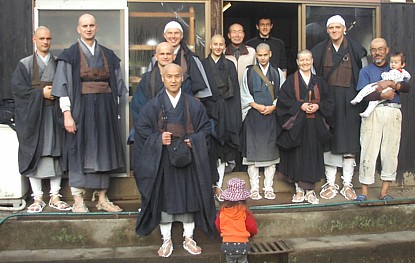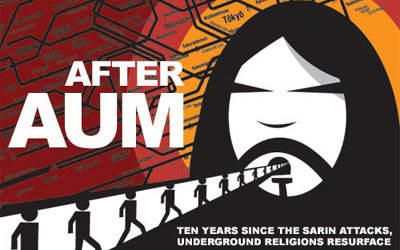|
|---|
 Obstructed by the kesa How to sit 12 (Adult Practice - Part XXXII) |
Following the paragraph on "Preparing yourself", "How To Do Zazen" continues with a section on clothing:
Avoid wearing either dirty or soiled clothing as well as luxurious or expensive garments. It is also advisable to avoid heavy garments. Wear your clothing loosely but neatly. In Japanese monasteries, socks are not worn in the zendô. Try to sit zazen in a tight pair of jeans, and you will realize why Sawaki recommends wearing your cloths loosely. Even when you sit naked, zazen can be painful on the legs. With tight wear, it will be much worse. In many Zen communities in the West, people have to dress in dark cloths to not stand out of the crowd. In Antaiji, we do not insist on dark cloths (except for monks, who dress in black robes), but we wear neither socks nor cover our heads, even when it is very cold. In the Fukanzazengi, Dôgen Zenji tells us to "tie the robes loosely and arrange them neatly." In the Zazengi however, he adds: "When you do zazen, wear a kesa (kashâya)." Although Sawaki Rôshi does not mention the kesa in "How To Do Zazen", he often is quoted as saying: "Putting on the o-kesa and just sitting - that is all!" Thus he sometimes seems to be giving the same importance to the o-kesa than he gives to the practice of just sitting. In the Sôtô Zen sect, the o-kesa is normally worn for zazen, except for the early morning sitting, before we recite the Takkesage. Under the o-kesa we wear the Chinese style monk's robes (koromo), under the robes we wear Japanese style kimono and juban, and under the juban Western underwear (Japanese monks today also usually wear Western style underwear). Except for the hottest weeks in summer, that is the kind of outfit that Antaiji monks dress up in as well. Still, some people might ask themselves why putting on the o-kesa should be given the same importance than the practice of just sitting? Why can't we just sit without putting on the o-kesa? I myself had this doubt when I ordained more than a decade ago. At the time, I was asked to write about my ordination in the Antaiji newsletter, and I am extremely embarresed when I read today the words that I wrote at the time: "To ordain as a monk means to leave home, which in turn can be defined as being reborn in this very life. But: Isn't each of us reborn over and over, every single instant, thousands of times during the duration of one period of zazen alone? I thought that the ordination ceremony was a mere ordeal that symbolizes this constant transformation of the self, but ordaining myself, I realized there was more to it: I had to change my cloths as well. A monk dresses in robes and the kesa, and I almost regret having become a monk in the first place when I experience how difficult it is to practice zazen in all this decorum..." Usually, when people ordain and write about it, they will express feelings of gratitude towards their teacher or the sangha, and they will try to formulate their future goals, having made a first step on the path of the bodhisattva. Someone who has aroused the mind of the way is usually burning with the desire to live for others, he forgets about himself. Sadly, reading my own words, I find nothing of that in them. Just the complaint that sitting in monk's robes isn't easy. Why then have you become a monk in the first place? I would like to ask myself now. At the time, I also had thoughts like this: "We do not put on the kesa in the morning, when it is still quite chilly. On the other hand, we put it on at night, when it can be quite warm. Wouldn't it be more intelligent to do it the other way around? Keeping warm in the morning and cool at night?" Here is a sentence from the page About Antaiji of this homepage: "What is most important is not to use the buddha way for your own purposes, but rather to give up your own ideas and throw yourself completely into the practice of the way." The attitude that I had when I ordained as a monk is a good example of someone who is trying to use the buddha way for his own purposes. I was evaluating the o-kesa, asking if it helped me with my practice or not. I certainly was not giving up my ideas and throwing myself completely into the o-kesa. But if somebody would have told me that, for sure I would have argued back: "Why? You wouldn't say that the kesa is the buddha way, would you? The kesa is just a piece of cloth you wear - but aren't we here to learn about the essence of it all, the buddha dharma? I am here to study the content of the teaching, I'm certainly not interested in surfacial practices like putting on the kesa or putting down my chopsticks this way or that!" But I was wrong. Sawaki Rôshi often makes the point that you can't really tell the form from the content. The content has to manifest in the form, the form has to be a pointer to the content. If you try to devide them, you are fooling yourself. The "buddha dharma" that I made up in my mind was nothing than that - a thought in my mind. But the dharma is not in the mind, it is right in front of our eyes, and in such every day business like arranging your slippers when you come out of the toilet (or - as I love to say - in the simple action of wiping your own ass). When it comes to the o-kesa, Sawaki Rôshi says that "the robe (or o-kesa in this case) and the dharma are one". When I made fun of the o-kesa, I was making fun of the dharma. For me the o-kesa was just a piece of cloth, I wasn't prepared to see it as just another manifestation of dharma. As a matter of fact, the o-kesa is a piece of cloth, or to be more precise, several pieces of cloth sewn together. Still in Zendan, the book that Sawaki's instructions for zazen were originally taken from, he says in the chapter about the o-kesa: "To transmit the o-kesa means to transmit the very essence of the buddha dharma." "To shave your head, put on the o-kesa and sit in zazen: that is the last goal, there is nothing beyond to aim at." Sawaki Rôshi became interested in the o-kesa when he was 19 or 20, but for a long time he couldn't find any one who would teach him about it. Only ten years later, at age 30, he met a nun from the Shingon sect and wore a kesa that Sawaki considered to be authentic. Through this nun, he learned about several sutras that explained about the importance of the o-kesa. Thus his study of the o-kesa begun. But not everyone was as enthusiastic about the o-kesa as Sawaki. Already at his time there were monks like myself: "There are monks who call the o-kesa a straitjacket. What a pity: they are caught up in it, it gives them no freedom at all! Actually, this aspect of the o-kesa makes it so precious." When I did zazen wearing a kesa for the fist time, I also felt that it took my freedom. But why should that make the o-kesa precious? In the Fukanzazengi and also the Gakudôyôjinshû, we hear Dôgen Zenji say that when we give ourselves to the sitting, we are obstructed by the sitting. Why should we be obstructed by zazen? Isn't zazen supposed to liberate us? I think this experience of being obstructed in zazen is made because of our deluded nature. It is the deluded being (bonpu) in ourselves that feels as if he was caught in a straitjacket when having to sit still for 50 minutes or a whole hour. From the side of the buddha dharma, that means nothing more than that our deluded nature is embraced by and folded up in zazen. For the deluded being, it might feel like a lack of freedom, for the buddha on the other hand, there is no such restriction at all. And I think the same is true for the o-kesa. It might feel like a straitjacket at first, but that is just because we manifest our buddha nature with this very body of the deluded being. For the buddha there is nothing wrong with the o-kesa. It's only the deluded being that feels more comfortable in T-shirt and short pants. I want to continue to think about the meaning of the o-kesa and some problems with the blind believe in its importance next month.
(to be continued ... Dôchô)
|
|---|

|
 My understanding of BuddhismTen years since Aum (Part 9) |
Everyone - except a follower of the Aum or Aleph cult, as it is now called - will agree that Aum is not real Buddhism. The real question though is not if Aum is Buddhism or not, but if we - who claim that Aum isn't "real Buddhism" - really practice Buddhiosm ourselves or not. To answer this question, we first have to clarify what Buddhism is about in the first place. Therefore I want to try to sketch my own understanding of Buddhism.
Buddhism can be roughly divided into Theravada Buddhism, Mahayana Buddhism and Tibetan Buddhism, but it goes without saying that all of Buddhism originates with Shakyamuni, the historical Buddha who lived in India 2500 years ago. The basics of his original teaching were the so called three Dharma seals of suffering, impermanence and non-self (non-substantiality). Shakyamuni's starting point was the realization that "all is suffering". The Buddha left home when he awakened to the truth that being born into this world, growing older, become sick and dying are all essentially expressions of suffering. Actually, I think that the realization of the truth of suffering is not only the staring point of Buddhism, but also its final goal. That is to say that it's not the goal for a Buddhist to get "out of" suffering. It's more about accepting our suffering, and it is only this acceptance that enables us to not suffer from suffering. Suffering means in more precise terms the non-satisfactoriness of reality. We always feel that something is missing, and that is all there is to it. But we don't want to accept that, and the more we try to get our hands on that special thing that we suppose is missing, the stronger our feeling of dissatisfaction grows. Humans are animals that are designed to be dissatisfied. And probably not only humans, but all living beings are designed in a way that they are always craving for more, never being able to settle down completely satisfied in the "here and now" - their present situation. Therefore, it is only natural for us to think that "something is missing". Being not satisfied is our nature. This feeling of dissatisfaction has to do with the second Dharma seal, impermanence. "All is suffering" doesn't mean that we are actually experiencing some form of suffering all the time. Sesshin might feel like hell, but even in a Zen moanstery life can be fun at times. But fun never lasts for ever. Even though we feel good now, we can not preserve this "good feeling" for too long. There was someone who said that complete happiness never lasts longer than five minutes, and he was probably right. Momentary satisfaction is always followed by the feeling that "something is still missing". But impermance is not necessarily a negative phenomenon (just as suffering is nothing negative, but just natural). It basically means that all things are in a constant process of change and flow. Nothing stands still even for a second. The reason for this is the third Dharma seal, non-self or non-substantiality. Things don't have a firm core that would define their identity. We label things, calling them "me, you, him and her", but originally there is no such thing. Physics has found out that "atoms" - literally "the undevidables" - can be devided, and those smaller particles which in turn were called "elementary" particles aren't really elementary at all. They all manifest and dissolve with the flow of energy, having no lasting identity. We might have no problems accepting non-substantiality when we talk about elementary physics, but it is a different problem when it comes to ourselves. We say: "I live". And therefore it becomes a problem when we realize that we'll have to die as well. Buddhism teaches that there is no such "I" that lives or dies, it is just the all compassing activity of living-and-dying that manifests. Anyway, Buddhism starts out with the denial of a self (and that goes for the "Self" with capital "S" as well! But about that, later...). That is the reason why Shakyamuni refused to answer questions about life after death, because all of these questions are based on the wrong assumption that there is some kind of "me" that experiences life and death, and that will continue to exist even after death. When we want to practice Buddhism, we have to forget about this idea of "myself" first thing. Also, Buddhism is for the living, not for the dead. Shakyamuni didn't preach for the comfort of the "souls of the deceased". It is a peculiar habit in Japanese Buddhism to refer to a corpse as "hotoke", which is the Japanese term for "Buddha". Buddha is the Sanskrit word for an awakened one - what could be farer removed from that than a corpse? The idea of course is that the soul of the deceased person becomes a Buddha after death, but Shakyamuni didn't teach such a thing in any of the sutras, it is a false believe spread in part to comfort the relatives who worry about the deceased one, in part it is just a way to make people donate huge sums of money to the Buddhist priest, as the deceased person's fate is supposed to be in the hands of the priest. But there is nothing "Buddhist" about this pagan belief. That the soul of a dead person remains in some form or the other, and that you can influence its condition by making offerings and the like, is a belief common in many places in the world. It isn't bad at all, it just isn't Buddhism. Funnily, in Japan everyone seems to think that Buddhism is nothing but funeral rites, while no-one would marry in a Buddhist temple for example. Buddhism, being associated with impermanence, would foreshadow the inevitable separation of the couple to be married. Therefore even Buddhist priests sometimes will hire a Catholic priest to perform their wedding cerenmony in some Christian chapel, which promises "joy forever". It is almost understandable that quite a number of prominent Japanese scholars of religious studies proclaimed (before the Salin incident of course) that Aum is much more Buddhist than the established Japanese Buddhism. Not that Aum is Buddhism, it's just that Japanese established Buddhism (like Sôtô Zen) isn't either. For both counts what the Sôtô Headquarters say about Aum: "Their teaching seems to be Buddhism at first sight, but in reality it isn't Buddhist at all." But while Japanese Buddhism almost never tries to address the problems of us human beings living in modern society, Aum tried - with fatal consequences.
(to be continued ... Muhô Nölke)
|
|---|
